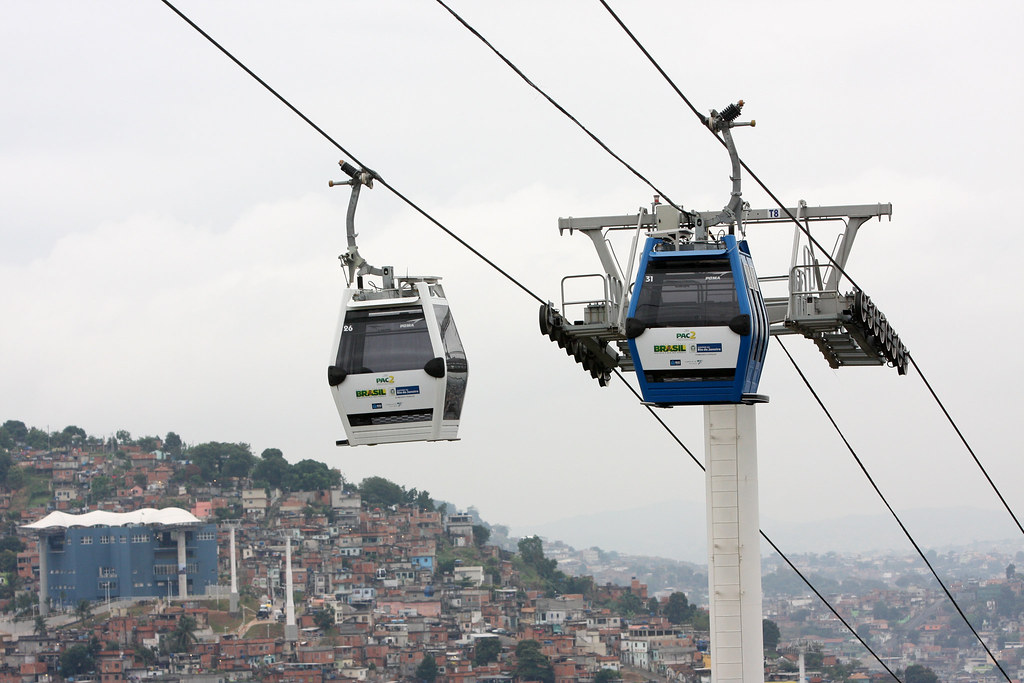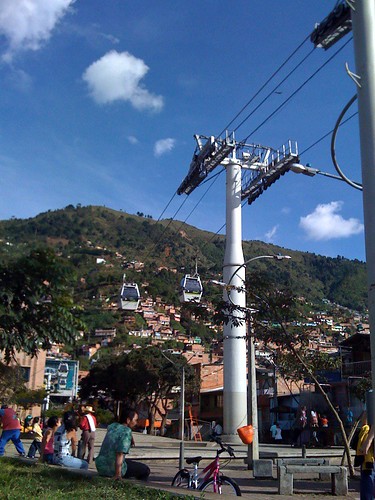
Teleférico do Alemão in Rio de Janeiro, Brazil (2011). At 3.5km, with 6 stations, it is one of the world's largest CPT systems. Image by Flickr User minplanpac.
Monocable Detachable Gondolas (MDG) are likely the most common CPT system you’ll encounter as their low cost has made them an attractive addition to public transit systems in the developing world. Systems like the Medellin MetroCable, Telecabine de Constantine and Caracas Metrocable all use MDG technology.
Characterized by a detachable grip which allows for intermediary stations and corner turning, MDG’s utilize a single cable (hence, monocable) for both propulsion and support. This means that the cable that pulls the vehicles is also the cable that supports the vehicle.
MDG Stats:
- Maximum Speed: 22 km/hr.
- Maximum Capacity: 3,000 persons per hour per direction.
- Vehicle Capacity: 4 – 15 persons.
- Cost: $5 – 20 million (US) / kilometre.
MDG’s suffer from a relatively low capacity (though still comparable to many urban tram routes) and given their single cable are prone to stoppages due to winds in excess of 50 km/hr. MDGs are therefore most useful in calm wind environments with low capacity needs.
As the investment is quite low compared to other technologies, MDGs are excellent “starter” systems for cities intrigued by the technology but question its effectiveness. A short, low-capacity feeder line, for example, would be a fine place for cities to experiment with MDG technology.

The Medellin MetroCable is one of the world's most successful Cable Propelled Transit systems. It utilizes MDG technology.
Proceed to Technologies Module, 3: BDG.
Return to Technologies Module, 1: Introduction
Creative Commons images by Big C Harvey and Felimartinez.

21 Comments
Hey,
I’m reading your descpription of the different CPT systems, and just noticed a difference between old and new posts.
In this post above, you say that maximal wind resistance for MGD is 50 km/h, and 70 km/h in the “new” post ( https://www.gondolaproject.com/mdg/ ). Why is there a difference? Did the technology significantly improve?
Thanks!
(I miswrote my email in the previous comment, sorry!)
Hey,
I’m reading your descpription of the different CPT systems, and just noticed a difference between old and new posts.
In this post above, you say that maximal wind resistance for MGD is 50 km/h, and 70 km/h in the “new” post ( https://www.gondolaproject.com/mdg/ ). Why is there a difference? Did the technology significantly improve?
Thanks!